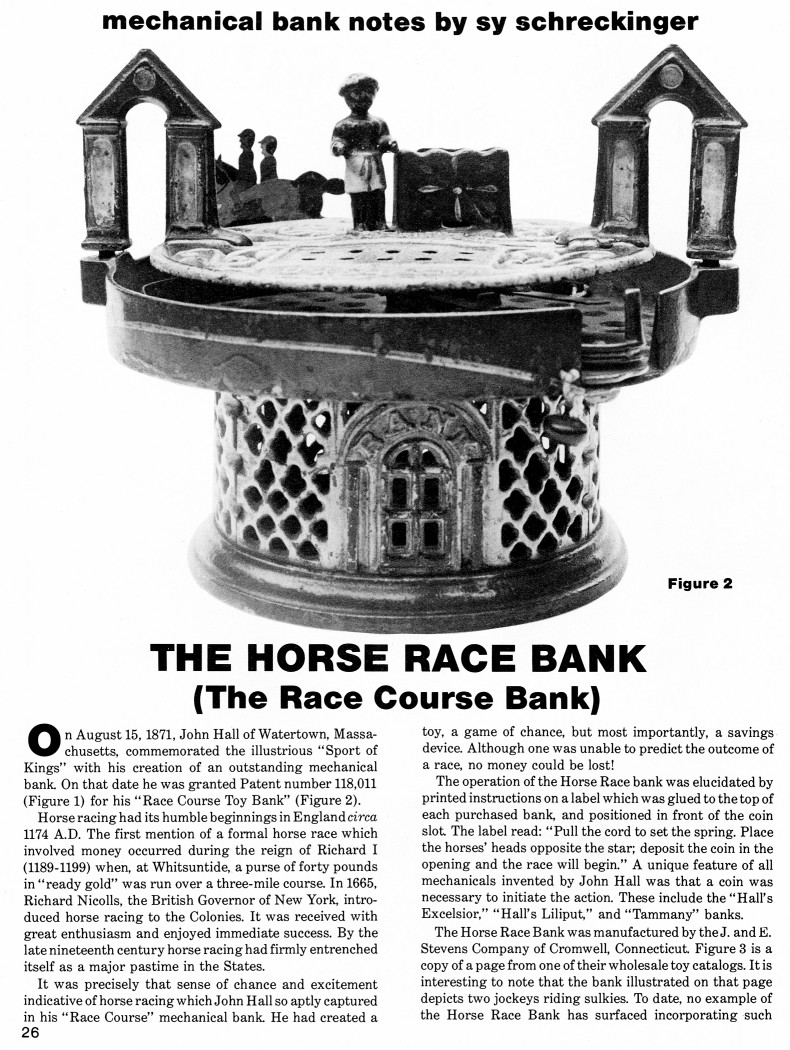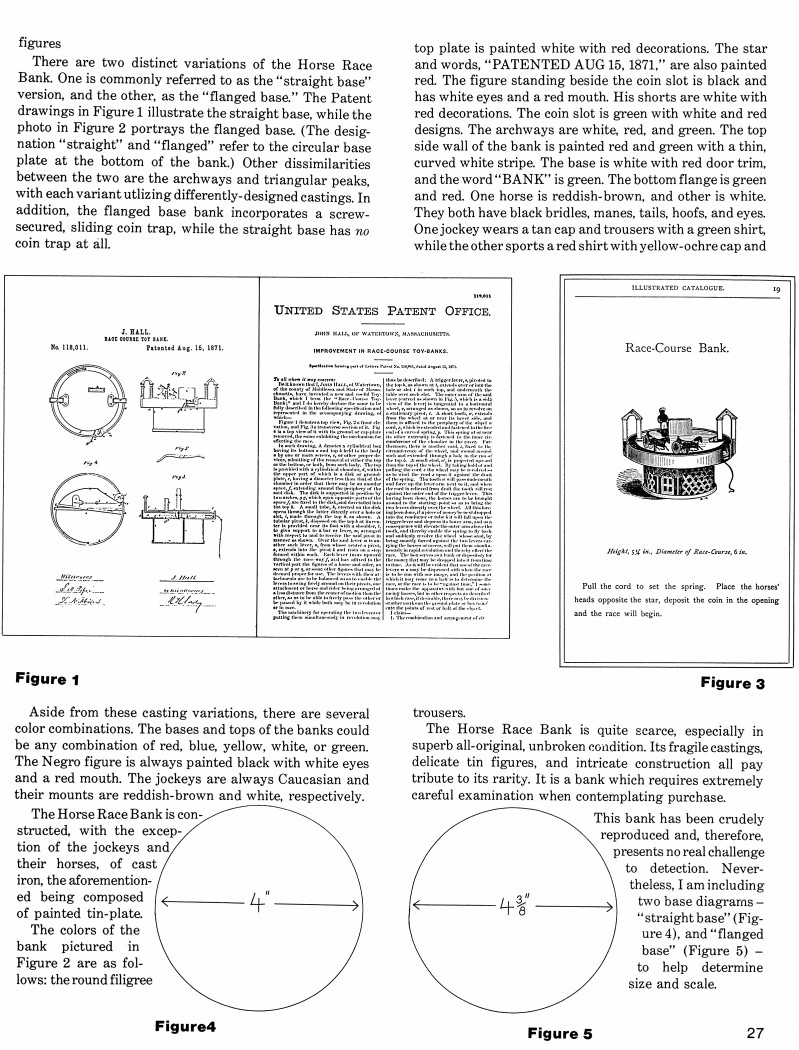|
The Horse Race Bank
(The Race Course Bank)
by Sy Schreckinger – ANTIQUE TOY WORLD Magazine – April, 1987
On August 15, 1871,
John Hall of Watertown, Massachusetts, commemorated the illustrious
"Sport of Kings" with his creation of an outstanding mechanical bank. On
that date he was granted Patent number
118,011 (Figure 1) for his "Race
Course Toy Bank" (Figure 2).
Horse racing had its humble beginnings in England circa 1174 A.D. The
first mention of a formal horse race which involved money occurred during
the reign of Richard I (1189-1199) when, at Whitsuntide, a purse of forty
pounds in "ready gold" was run over a three-mile course. In 1665, Richard
Nicolls, the British Governor of New York, introduced horse racing to the
Colonies. It was received with great enthusiasm and enjoyed immediate
success. By the late nineteenth century horse racing had firmly entrenched
itself as a major pastime in the States.
It was precisely that sense of chance and excitement indicative of
horse racing which John Hall so aptly captured in his "Race Course"
mechanical bank. He had created a toy, a game of chance, but most
importantly, a savings device. Although one was unable to predict the
outcome of a race, no money could be lost!
The operation of the Horse Race bank was elucidated by printed
instructions on a label which was glued to the top of each purchased bank,
and positioned in front of the coin slot. The label read: "Pull the cord
to set the spring. Place the horses' heads opposite the star; deposit the
coin in the opening and the race will begin." A unique feature of all
mechanicals invented by John Hall was that a coin was necessary to
initiate the action. These include the "Hall's Excelsior," "Hall's Liliput,"
and "Tammany" banks.
The Horse Race Bank was manufactured by the J. and E. Stevens Company
of Cromwell, Connecticut. Figure 3 is a copy of a page from one of their
wholesale toy catalogs. It is interesting to note that the bank
illustrated on that page depicts two jockeys riding sulkies. To date, no
example of the Horse Race Bank has surfaced incorporating such figures.
There are two distinct variations of the Horse Race Bank. One is
commonly referred to as the "straight base" version, and the other, as the
"flanged base." The Patent drawings in Figure 1 illustrate the straight
base, while the photo in Figure 2 portrays the flanged base. (The
designation "straight" and "flanged" refer to the circular base plate at
the bottom of the bank.) Other dissimilarities between the two are the
archways and triangular peaks, with each variant utilizing differently-designed castings. In addition, the flanged base bank incorporates a
screw-secured, sliding coin trap, while the straight base has no coin trap
at all.
Aside from these casting variations, there are several color
combinations. The bases and tops of the banks could be any combination of
red, blue, yellow, white, or green. The Negro figure is always painted
black with white eyes and a red mouth. The jockeys are always Caucasian
and their mounts are reddish-brown and white, respectively.
The Horse Race Bank is constructed, with the exception of the
jockeys and their horses, of cast iron, the aforementioned being composed
of painted tin-plate.
The colors of the bank pictured in Figure 2 are as follows: the
round filigree top plate is painted white with red decorations. The star
and words, "PATENTED AUG 15, 1871," are also painted red. The figure
standing beside the coin slot is black and has white eyes and a red mouth.
His shorts are white with red decorations. The coin slot is green with
white and red designs. The archways are white, red, and green. The top
side wall of the bank is painted red and green with a thin, curved white
stripe. The base is white with red door trim, and the word "BANK" is
green. The bottom flange is green and red. One horse is reddish-brown, and
other is white. They both have black bridles, manes, tails, hoofs, and
eyes. One jockey wears a tan cap and trousers with a green shirt, while
the other sports a red shirt with yellow-ochre cap and trousers.
The Horse Race Bank is quite scarce, especially in superb
all-original, unbroken condition. Its fragile castings, delicate tin
figures, and intricate construction all pay tribute to its rarity. It is a
bank which requires extremely careful examination when contemplating
purchase.
This bank has been crudely reproduced and, therefore, presents no
real challenge to detection. Nevertheless, I am including two base
diagrams "straight base" (Figure 4), and "flanged base" (Figure 5) to help
determine size and scale.
|


